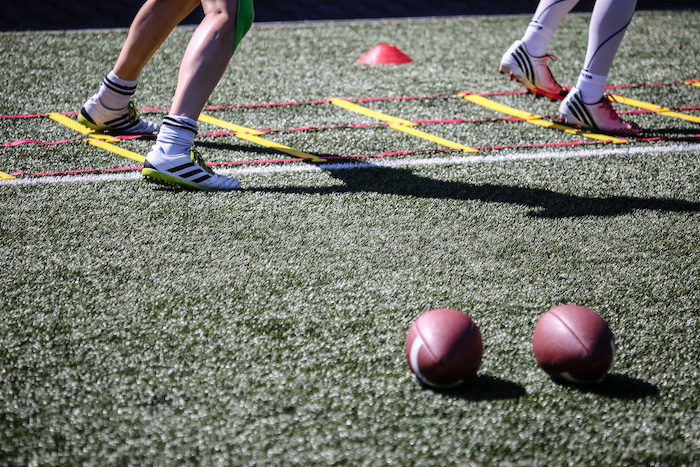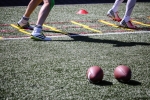
Early Artificial Turf: Ankle Sprains, Concussions and Major Knee Injuries
Artificial turf has been in use for over 40 years. The initial premise was to use nylon and other synthetic materials to create a surface that was simple to maintain and could be used for indoor stadiums. History has shown us that this noble goal is quite a challenge and a frequent subject of controversy.
AstroTurf™ was among the earliest artificial turfs first introduced in the mid 1960’s. Initially, it was praised for durability and minimal expense for upkeep. However, the novelty was eventually replaced by skepticism. Physicians and trainers began to notice that players were injured with a greater frequency on the artificial turf. These injuries included anterior cruciate ligament (ACL) tears, concussions, and ankle sprains.
John Powell from the University of Iowa was among the first to quantify the higher incidence of these injuries. He published a paper in 1992 that showed that professional football teams had more major knee injuries on artificial turf when compared to natural grass. Certain other injury patterns, such as turf burns and turf toe, were unique to artificial turf. Furthermore, players complained of greater muscle soreness when compared to playing on a natural grass surface.
Modern Artificial Turf Surfaces
Since that time, artificial turf companies have made significant strides to simulate more natural surfaces. Specifically, modern turfs are typically “infill” surfaces. The infill is composed of rubber (crumb rubber) or silica pellets and can be mixed with sand. The purpose of this infill is to simulate the dirt in between the blades of natural grass. This gives the field a more “grass-like” feel than traditional artificial turfs. Examples include FieldTurf™, AstroTurf Gameday Grass™, Sportsexe Momentum Turf™, and SprinTurf™. These fields have nylon or polyethylene fibers that attempt to replicate blades of grass. They have different heights and widths, depending on the manufacturer and the specific sport for which the surface was designed.
Despite these modern advancements, the effect of artificial turf on injury rates is still controversial. Players can still appreciate differences in texture and playability. Most scientists feel that two specific material properties of the turf can affect injury rates: the coefficient of friction, and the coefficient of restitution.
Coefficient of Friction: This relates to how sticky or “grabby” the surface is and how much force it will take for a planted foot to slip. For surfaces with high coefficients of friction (e.g. old AstroTurf™), this requires a large amount of force. It is these surfaces on which players say their foot gets “caught in the turf.” Studies have shown that there is a higher incidence of ACL injuries with surfaces that have a higher coefficient of friction.
Coefficient of Restitution: This is defined as the ability of a field to absorb shock. It is measured by using the G-Max value where one “G” represents one unit of gravity. The United States Consumer Products Safety Commission (USCPSC) has determined that fields with a G-Max of greater than 200 are unsafe for athletic play. For example, concrete has a high G-Max level and grass has a low G-Max level. Athletic fields with a high G-Max level place more impact on the athlete during a collision with the field. This translates to higher injury and concussion rates.
Artificial Turf in The Recent Press
In the past year, three artificial turf fields in New Jersey were closed due to high lead levels. These were older fields in which the lead levels were higher within the actual fibers of the artificial turf.
The U.S. Consumer Product Safety Commission investigated these surfaces and found that young children were not at risk from this lead exposure. Moreover, newer fields had no lead or had lower levels. The commission has still asked for the development of voluntary standards to prevent the inclusion of lead in future products.
Similarly, the carcinogenic effects of crumb rubber have also been investigated. To date, there is no research demonstrating a higher incidence of lead toxicity or cancer from using artificial surfaces. The New York State Department of Health has launched its investigation into these potential hazards, and its report is expected soon.
Artificial Turf vs. Natural Grass: An Ongoing Debate
Natural grass fields are not free from problems either. Some studies demonstrate that playing on a grass surface that is not well maintained may also increase injury rates.
This issue has become particularly important in cold-weather climate areas such as Green Bay, Minnesota, New England, and New York. In these areas, the weather can take a heavy toll on the fields, making them dangerous, despite the best efforts of ground crews.
Furthermore, many of the professional stadiums are high-traffic arenas where high school and college teams may play in addition to concerts, car shows, and other events. These circumstances virtually preclude the maintenance of a natural grass field within safe limits.
The Future of Playing Surfaces: Injury Prevention and Playability
To date, the optimum field conditions for both injury prevention and playability have yet to be determined. Ongoing research will help to determine which artificial fields are the safest, and it will also help to develop modifications of the existing products to reproduce the mechanical properties of well-maintained grass.
Precision Pain Care and Rehabilitation has two convenient locations in Richmond Hill – Queens, and New Hyde Park – Long Island. Call the Queens office at (718) 215-1888 or (516) 419-4480 for the Long Island office to arrange an appointment with our Interventional Pain Management Specialists, Dr. Jeffrey Chacko or Dr. Sonny Ahluwalia.















